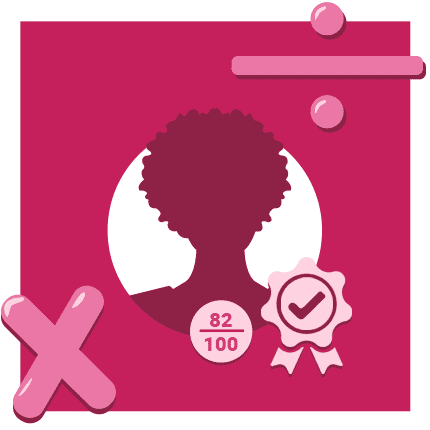Generating a high volume of leads is one thing while identifying which prospects are most likely to convert into customers is another. To put it differently, it’s all about quality over quantity.
That’s where lead scoring comes in. Let’s take a look at what lead scoring is and how you can calculate it effectively.
What is Lead Scoring?
In short, lead scoring involves gauging your prospects’ quality to determine which leads are worth pursuing and which ones are not. Usually, this process works on a point-based system.
You assign prospects points according to various attributes. More specifically, you can score leads based on implicit and explicit data.
Explicit information refers to factual data that your leads have confirmed through a phone call or by completing a form. On the other hand, implicit data is based on the information you already possess, like purchase history.
You can then break down both data sets into demographic and behavioral data. Demographic data refers to your leads’ company size, geographical information, or industry, while behavioral data focuses on information based on the actions your leads took, like form submissions.
What are the Benefits of Lead Scoring?
For starters, lead scoring makes the sales process more efficient. By identifying qualified and unqualified leads, you’ll no longer need to spend time cold-calling or personalizing sales emails to leads that will likely not bring any value to your business.
By getting bad leads out of the equation, you’ll likely be able to increase conversions with fewer sales representatives.
Consequently, lead scoring helps you save time and money. It also helps shift your sales efforts to high-value leads for better results.
In addition, a lead scoring system helps you improve your marketing strategy. You’ll get to identify which marketing channels bring in the most valuable leads, thus allowing you to determine which channels are worth investing in and which ones are not.
Moreover, lead scoring will improve the nurturing process, as it allows you to pinpoint where prospects are situated in the sales cycle.
You can use that information to send content dedicated to leads during each sales cycle stage. Consequently, you can create more meaningful relationships and close deals quicker.
Lastly, evaluating leads will help you get your sales and marketing teams on the same page. As mentioned earlier, having a lead scoring system requires data.
This information helps marketers understand what type of prospects are most likely to convert and how to create targeted campaigns to attract them. The marketing department can then hand over sales-ready leads to the sales team and help them generate more sales.
How to Score Leads Manually
Lead-to-Customer Conversion Rate
The lead-to-customer conversion rate represents the percentage of the company’s qualified leads that resulted in a sale. To calculate this metric, divide the number of qualified prospects that generated conversions by the total number of qualified leads.
Why is this metric important? It essentially acts as your sales team’s benchmark. It allows you to assess the performance of your sales funnel and helps you stack up multiple marketing channels against each other to identify which ones are most effective in generating high-quality leads.
Choose the Right Attributes for Your Model
Attributes are the backbone of your lead scoring model. They help you define and identify the characteristics of sales-ready prospects and give you an idea of how to improve lead quality.
That’s where the data we mentioned earlier comes in. First, identify the prospects that bring the most value to your business.
Second, take your implicit and explicit data sets and find similarities between your high-value leads by examining demographic and behavioral data. Upon reviewing the data, identify the characteristics that define high-quality prospects and assign the attributes accordingly.
Determine the Close Rate for All Attributes
Next up, it’s time to determine which attribute is more valuable than the other. You’ll first need to calculate the close rate for each attribute to do this. More specifically, identify how many prospects turn into customers depending on their behavior or demographics.
For instance, you could calculate the close rate of people who sign-up for your newsletter, follow you on social media, or determine the close rate of prospects within various regions or niches.
Assign Point Values
Upon determining the close rates for each attribute, you’ll need to compare them and prioritize one over another.
For instance, recent Instagram statistics show that marketers grade influencer marketing as their fastest-expanding customer acquisition channel. So you may find out that more prospects from influencer campaigns turn into customers than prospects who signed up for your newsletter.
In that case, the former attribute is more valuable. Repeat the process for each specific attribute to define the characteristics that accurately reflect lead quality.
Furthermore, compare the close rates of your attributes to your overall close rate. This will act as a reference point when assigning scores for your attributes.
For example, if newsletter sign-ups have a close rate of 15%, whereas your overall close rate is one percent, you could assign each lead that registers to your newsletter 15 points.
Setting a minimum score threshold is also recommended to draw the line between qualified and unqualified prospects easier. For instance, leads with a score below 50/100 points may not be worth pursuing.
Other Types of Lead Scoring
Aside from the manual approach, there are also other methods of scoring leads. More specifically, predictive and logistics regression lead scoring.
Predictive lead scoring might be your best bet if you’re looking to save time. This method uses machine learning to go through prospect data to find common points between leads that convert and leads that do not and rank each prospect based on their likelihood of converting.
Predictive lead scoring eliminates the need to manually sift through data to identify valuable attributes and minimizes the risk of human errors.
Moreover, since predictive lead scoring systems use machine learning technology, you won’t need to optimize your follow-up strategy manually.
On the other hand, the main strength of logistic regression lead scoring systems lies in their accuracy, as it considers how all customer attributes interact with one another.
This is a data mining technique that uses Microsoft Excel. It works by building a formula in the spreadsheet which will reveal the probability of turning a prospect into a customer.
Conclusion
Overall, lead scoring is crucial for identifying high-value prospects and giving you an insight into how you could lower your cost per lead.
Start by determining your lead-to-conversion late. After that, choose the right attributes depending on your customer information, calculate the close rate of each attribute, and sort them based on their importance.




